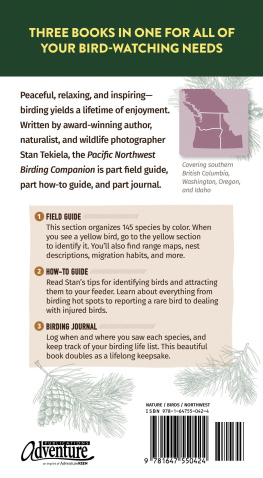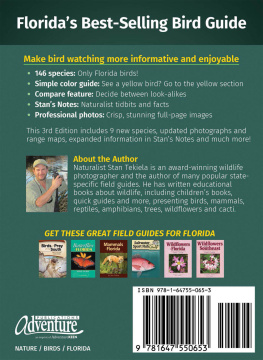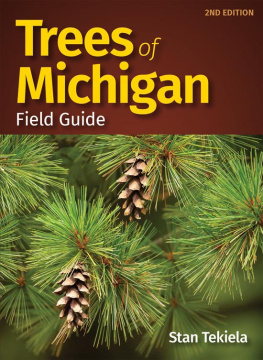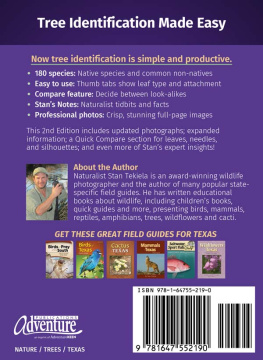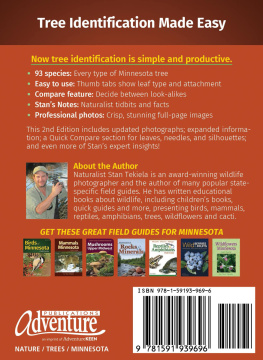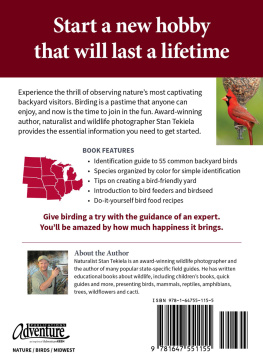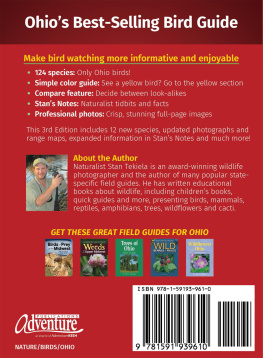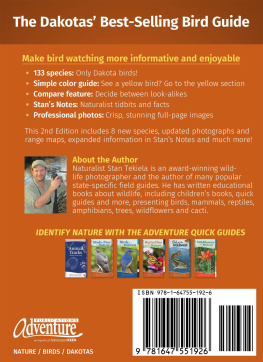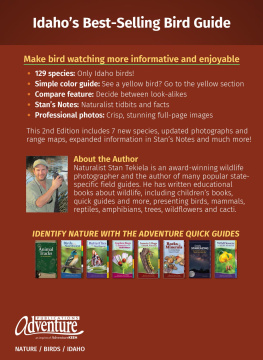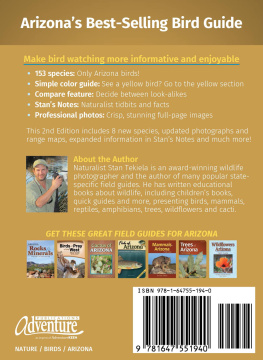

To Agnieszka Bacal
Edited by Sandy Livoti, Brett Ortler and Dan Downing
Book and cover design and illustrations by Jonathan Norberg
Range maps produced by Anthony Hertzel
Photo credits by photographer and page number:
Cover photo: American Goldfinch by Stan Tekiela
All photos by Stan Tekiela except ) by Jim Zipp .
To the best of the publishers knowledge, all photos were of live birds.
10 9 8 7 6 5 4 3 2 1
Pacific Northwest Birding Companion
Copyright 2021 by Stan Tekiela
Published by Adventure Publications, an imprint of AdventureKEEN
310 Garfield Street South
Cambridge, Minnesota 55008
(800) 678-7006
www.adventurepublications.net
All rights reserved
Printed in China
ISBN 978-1-64755-042-4 (pbk.); ISBN 978-1-64755-043-1 (ebook)
TABLE OF CONTENTS
WHY WATCH BIRDS IN THE PACIFIC NORTHWEST?
Millions of people have discovered bird feeding. Its a simple and enjoyable way to bring the beauty of birds closer to your home. Watching birds at your feeder often leads to a lifetime pursuit of bird identification. This Birding Companion to Washington, Oregon, Idaho and the southern portion of British Columbia is a new approach to bird watching.
With a large size and beautiful full-color photographs that make identifications even easier, this contains 145 species of birds in the Pacific Northwest, from common backyard and shoreside visitors to birds only seen during migration and rarer visitors that are only seen on occasion.
But this book is more than just an identification guide. Each page also includes space for keeping track of where and when you spotted each species, and theres also a life list in the back to keep track of all of your observations.
The book also includes:
Birding hotspots across the region
Details about birding festivals and events
Information about citizen science and bird counts, how to report a rare bird and the basics of what to do if you suspect you find an injured bird.
There are over 1,100 species of birds found in North America. In Washington State alone more than 518 different kinds of birds have been recorded throughout the years. These bird sightings were diligently recorded by hundreds of bird watchers and became part of the official state record. The story is much the same in Oregon, where 543 have been recorded; Idaho, where 432 are recorded; and British Columbia, where an amazing 522 species have been recorded throughout the province.
Bird watching, often called birding, is one of the most popular activities in America. Its outstanding appeal in the Pacific Northwest is due, in part, to an unusually rich and abundant birdlife. Why are there so many birds? One reason is open space: Oregon covers more than 98,000 square miles; Idaho spans more than 83,000 square miles; and Washington State spans more than 70,000 square miles. British Columbia dwarfs them all at over 300,000 square miles.
Open space is not the only reason there is such an abundance of birds. Its also the diversity of habitat. From the temperate rainforests and tidepool-covered beaches of the Pacific Coast to the towering peaks and to the craggy scablands of Eastern Washington, the Pacific Northwest covers a wide range of habitats, elevations and environments.
No matter if you are in the cool, dry scablands or the moist forest of the Hoh Rain Forest, there are birds to watch in each season. Whether witnessing hawks migrating in autumn or welcoming back hummingbirds in spring, there is variety and excitement in birding as each season turns to the next.
OBSERVE WITH A STRATEGY; TIPS FOR IDENTIFYING BIRDS
Identifying birds isnt as difficult as you might think. By simply following a few basic strategies, you can increase your chances of successfully identifying most birds you see! One of the first and easiest things to do when you see a new bird is to note its color. (Also, since this book is organized by color, you will go right to that color section to find it.)
Next, note the size of the bird. A strategy to quickly estimate size is to select a small-, medium- and large-sized bird to use for reference. For example, most people are familiar with robins. A robin, measured from tip of the bill to tip of the tail, is 10 inches (25 cm) long. Using the robin as an example of a medium-sized bird, select two other birds, one smaller and one larger. Many people use a House Sparrow, at about 6 inches (15 cm), and an American Crow, about 18 inches (45 cm). When you see a bird that you dont know, you can quickly ask yourself, Is it smaller than a robin, but larger than a sparrow? When you look in your field guide to help identify your bird, youll know its roughly between 6 and 10 inches (15 to 25 cm) long. This will help to narrow your choices.
Next, note the size, shape and color of the bill. Is it long, short, thick, thin, pointed, blunt, curved or straight? Seed-eating birds, such as Evening Grosbeaks, have bills that are thick and strong enough to crack even the toughest seeds. Birds that sip nectar, such as Black-chinned Hummingbirds, need long, thin bills to reach deep into flowers. Hawks and owls tear their prey with very sharp, curving bills. Sometimes, just noting the bill shape can help you decide if the bird is a woodpecker, finch, grosbeak, blackbird or bird of prey.
Next, take a look around and note the habitat in which you see the bird. Is it wading in a marsh? Walking along a riverbank? Soaring in the sky? Is it perched high in the trees or hopping along the forest floor? Because of their preferences in diet and habitat, youll usually see robins hopping on the ground, but not often eating the seeds at your feeder. Or youll see a Black-headed Grosbeak sitting on a branch of a tree, but not climbing down the tree trunk headfirst the way a nuthatch does.
Noticing what a bird is eating will give you another clue to help you identify that bird. Feeding is a big part of any birds life. Fully one-third of all bird activity revolves around searching for and catching food, or actually eating. While birds dont always follow all the rules of what we think they eat, you can make some general assumptions. Northern Flickers, for instance, feed upon ants and other insects, so you wouldnt expect to see them visiting a backyard feeder. Some birds, such as Barn Swallows and Cliff Swallows, feed upon flying insects and spend hours swooping and diving to catch a meal.
Sometimes you can identify a bird by the way it perches. Body posture can help you differentiate between an American Crow and a Red-tailed Hawk. American Crows lean forward over their feet on a branch, while hawks perch in a vertical position. Look for this the next time you see a large unidentified bird in a tree.
Birds in flight are often difficult to identify, but noting the size and shape of the wing will help. A birds wing size is in direct proportion to its body size, weight and type of flying. The shape of the wing determines if the bird flies fast and with precision, or slowly and less precisely. Birds such as House Finches, which flit around in thick tangles of branches, have short, round wings. Birds that soar on warm updrafts of air, such as Turkey Vultures, have long, broad wings. Barn Swallows have short, pointed wings that slice through air, propelling their swift and accurate flight.
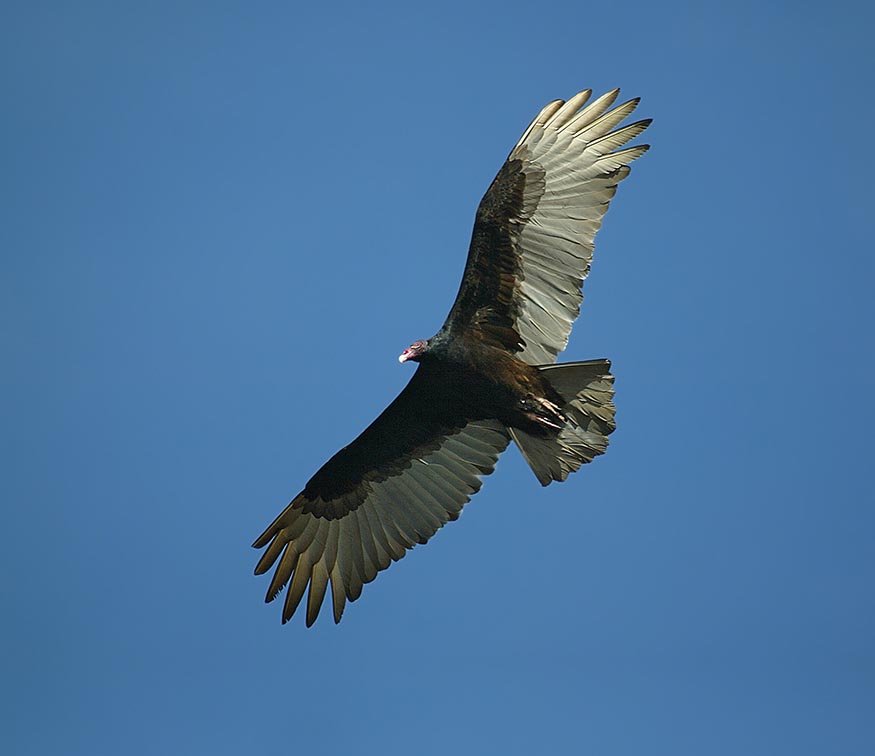
Next page
